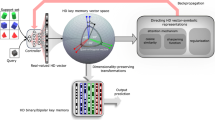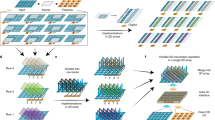Abstract
Disentangling the attributes of a sensory signal is central to sensory perception and cognition and hence is a critical task for future artificial intelligence systems. Here we present a compute engine capable of efficiently factorizing high-dimensional holographic representations of combinations of such attributes, by exploiting the computation-in-superposition capability of brain-inspired hyperdimensional computing, and the intrinsic stochasticity associated with analogue in-memory computing based on nanoscale memristive devices. Such an iterative in-memory factorizer is shown to solve at least five orders of magnitude larger problems that cannot be solved otherwise, as well as substantially lowering the computational time and space complexity. We present a large-scale experimental demonstration of the factorizer by employing two in-memory compute chips based on phase-change memristive devices. The dominant matrix–vector multiplication operations take a constant time, irrespective of the size of the matrix, thus reducing the computational time complexity to merely the number of iterations. Moreover, we experimentally demonstrate the ability to reliably and efficiently factorize visual perceptual representations.
This is a preview of subscription content, access via your institution
Access options
Access Nature and 54 other Nature Portfolio journals
Get Nature+, our best-value online-access subscription
$29.99 / 30 days
cancel any time
Subscribe to this journal
Receive 12 print issues and online access
$259.00 per year
only $21.58 per issue
Buy this article
- Purchase on Springer Link
- Instant access to full article PDF
Prices may be subject to local taxes which are calculated during checkout




Similar content being viewed by others
Data availability
The data that support the findings of this study are available via Zenodo at https://zenodo.org/record/7599430. Source data are provided with this paper.
Code availability
Our code is available via GitHub at https://github.com/IBM/in-memory-factorizer.
References
Feldman, J. The neural binding problem(s). Cogn. Neurodyn. 7, 1–11 (2013).
Land, E. H. & McCann, J. J. Lightness and retinex theory. J. Opt. Soc. Am. 61, 1–11 (1971).
Barrow, H. G. & Tenenbaum, J. M. in Computer Vision Systems 3–26 (Academic Press, 1978).
Adelson, E. & Pentland, A. in The Perception of Shading and Reflectance 409–424 (Cambridge Univ. Press, 1996).
Barron, J. T. & Malik, J. Shape, illumination and reflectance from shading. IEEE Trans. Pattern Anal. Mach. Intell. 37, 1670–1687 (2015).
Memisevic, R. & Hinton, G. E. Learning to represent spatial transformations with factored higher-order Boltzmann machines. Neural Comput. 22, 1473–1492 (2010).
Burak, Y., Rokni, U., Meister, M. & Sompolinsky, H. Bayesian model of dynamic image stabilization in the visual system. Proc. Natl Acad. Sci. USA 107, 19525–19530 (2010).
Cadieu, C. F. & Olshausen, B. A. Learning intermediate-level representations of form and motion from natural movies. Neural Comput. 24, 827–866 (2012).
Anderson, A. G., Ratnam, K., Roorda, A. & Olshausen, B. A. High-acuity vision from retinal image motion. J. Vision 20, 34 (2020).
Smolensky, P. Tensor product variable binding and the representation of symbolic structures in connectionist systems. Artif. Intell. 46, 159–216 (1990).
Jackendoff, R. Foundations of Language: Brain, Meaning, Grammar, Evolution (Oxford Univ. Press, 2002).
Hummel, J. E. & Holyoak, K. J. Distributed representations of structure: a theory of analogical access and mapping. Psychol. Rev. 104, 427–466 (1997).
Kanerva, P. in Advances in Analogy Research: Integration of Theory and Data from the Cognitive, Computational and Neural Sciences 164–170 (New Bulgarian Univ., 1998).
Kanerva, P. Pattern completion with distributed representation. In International Joint Conference on Neural Networks 1416–1421 (IEEE, 1998).
Plate, T. A. Analogy retrieval and processing with distributed vector representations. Expert Syst. Int. J. Knowledge Eng. Neural Netw. 17, 29–40 (2000).
Gayler, R. W. & Levy, S. D. A distributed basis for analogical mapping: new frontiers in analogy research. In New Frontiers in Analogy Research, Second International Conference on the Analogy 165–174 (New Bulgarian University Press, 2009).
Gayler, R. W. Vector symbolic architectures answer Jackendoff’s challenges for cognitive neuroscience. In Joint International Conference on Cognitive Science 133–138 (Springer, 2003).
Plate, T. A. Holographic reduced representations. IEEE Trans. Neural Netw. 6, 623–641 (1995).
Plate, T. A. Holographic Reduced Representations: Distributed Representation for Cognitive Structures (Stanford Univ., 2003).
Kanerva, P. Hyperdimensional computing: an introduction to computing in distributed representation with high-dimensional random vectors. Cogn. Comput. 1, 139–159 (2009).
Frady, E. P., Kent, S. J., Olshausen, B. A. & Sommer, F. T. Resonator networks, 1: an efficient solution for factoring high-dimensional, distributed representations of data structures. Neural Comput. 32, 2311–2331 (2020).
Hersche, M., Zeqiri, M., Benini, L., Sebastian, A. & Rahimi, A. A neuro-vector-symbolic architecture for solving Raven’s progressive matrices. Nat. Mach. Intell. https://doi.org/10.1038/s42256-023-00630-8 (2023).
Lanza, M. et al. Memristive technologies for data storage, computation, encryption and radio-frequency communication. Science 376, eabj9979 (2022).
Sebastian, A., Le Gallo, M., Khaddam-Aljameh, R. & Eleftheriou, E. Memory devices and applications for in-memory computing. Nat. Nanotechnol. 15, 529–544 (2020).
Wang, Z. et al. Resistive switching materials for information processing. Nat. Rev. Mater. 5, 173–195 (2020).
Kent, S. J., Frady, E. P., Sommer, F. T. & Olshausen, B. A. Resonator networks, 2: factorization performance and capacity compared to optimization-based methods. Neural Comput. 32, 2332–2388 (2020).
Wong, H.-S. P. & Salahuddin, S. Memory leads the way to better computing. Nat. Nanotechnol. 10, 191–194 (2015).
Chua, L. Resistance switching memories are memristors. Appl. Phys. A 102, 765–783 (2011).
Shin, J. H., Jeong, Y. J., Zidan, M. A., Wang, Q. & Lu, W. D. Hardware acceleration of simulated annealing of spin glass by RRAM crossbar array. In Proc. IEEE International Electron Devices Meeting 3.3.1–3.3.4 (IEEE, 2018).
Bojnordi, M. N. & Ipek, E. Memristive Boltzmann machine: a hardware accelerator for combinatorial optimization and deep learning. In Proc. IEEE International Symposium on High Performance Computer Architecture 1–13 (IEEE, 2016).
Mahmoodi, M. R., Prezioso, M. & Strukov, D. B. Versatile stochastic dot product circuits based on nonvolatile memories for high performance neurocomputing and neurooptimization. Nat. Commun. 10, 5113 (2019).
Borders, W. A. et al. Integer factorization using stochastic magnetic tunnel junctions. Nature 573, 390–393 (2019).
Wan, W. et al. 33.1 A 74 TMACS/W CMOS-RRAM neurosynaptic core with dynamically reconfigurable dataflow and in-situ transposable weights for probabilistic graphical models. In Proc. IEEE International Solid-State Circuits Conference 498–500 (IEEE, 2020).
Kumar, S., Strachan, J. P. & Williams, R. S. Chaotic dynamics in nanoscale NbO2 Mott memristors for analogue computing. Nature 548, 318–321 (2017).
Cai, F. et al. Power-efficient combinatorial optimization using intrinsic noise in memristor Hopfield neural networks. Nat. Electron. 3, 409–418 (2020).
Yang, K. et al. Transiently chaotic simulated annealing based on intrinsic nonlinearity of memristors for efficient solution of optimization problems. Sci. Adv. 6, eaba9901 (2020).
Khaddam-Aljameh, R. et al. Hermes core—a 14nm CMOS and PCM-based in-memory compute core using an array of 300ps/LSB linearized CCO-based ADCs and local digital processing. In 2021 Symposium on VLSI Circuits 1–2 (IEEE, 2021).
Tuma, T., Pantazi, A., Le Gallo, M., Sebastian, A. & Eleftheriou, E. Stochastic phase-change neurons. Nat. Nanotechnol. 11, 693–699 (2016).
Le Gallo, M., Krebs, D., Zipoli, F., Salinga, M. & Sebastian, A. Collective structural relaxation in phase-change memory devices. Adv. Electron. Mater. 4, 1700627 (2018).
Le Gallo, M. & Sebastian, A. An overview of phase-change memory device physics. J. Phys. D Appl. Phys. 53, 213002 (2020).
Zhang, C., Gao, F., Jia, B., Zhu, Y. & Zhu, S.-C. RAVEN: a dataset for relational and analogical visual reasoning. In Proc. IEEE/CVF Conference on Computer Vision and Pattern Recognition (CVPR) 5312–5322 (IEEE, 2019).
Kent, S. Multiplicative Coding and Factorization in Vector Symbolic Models of Cognition. PhD thesis, Univ. California (2020).
Kleyko, D. et al. Integer factorization with compositional distributed representations. In Proc. 9th Annual Neuro-Inspired Computational Elements Conference 73–80 (ACM, 2022).
Li, J. et al. Low angle annular dark field scanning transmission electron microscopy analysis of phase change material. In Proc. International Symposium for Testing and Failure Analysis 2021 206–210 (ASM, 2021).
Acknowledgements
This work is supported by the IBM Research AI Hardware Center and by the Swiss National Science Foundation (SNF) (grant no. 200800). We thank M. Le Gallo for the technical help; K. Brew and J. Li for assistance with TEM imaging of PCM devices; and V. Narayanan, C. Apte and R. Haas for managerial support.
Author information
Authors and Affiliations
Contributions
J.L., G.K., M.H., A.S. and A.R. conceived the idea and designed the experiments. J.L. performed the experiments and characterization. J.L., A.S. and A.R. wrote the paper, with input from all the authors. All the authors provided critical comments and analyses.
Corresponding authors
Ethics declarations
Competing interests
The authors declare no competing interests.
Peer review
Peer review information
Nature Nanotechnology thanks Mario Lanza and Yuchao Yang for their contribution to the peer review of this work.
Additional information
Publisher’s note Springer Nature remains neutral with regard to jurisdictional claims in published maps and institutional affiliations.
Extended data
Extended Data Fig. 1 Desirable range of noise.
The aggregated noise corresponding to the programming noise, drift variability, and read noise in the PCM devices affects (a) the accuracy of factorization, and (b) the number of iterations to converge. The optimal range for the standard deviation of the noise lies between 0.293μS and 1.277μS. As indicated by the green vertical line, the level of noise observed in the experimental crossbar array lies within the desirable range of noise.
Supplementary information
Supplementary Information
Supplementary Notes 1–4, Tables 1–3 and Figs. 1–5.
This video showcases one application of the proposed in-memory factorizer. Here the visual attributes of an image are disentangled using a front-end convolutional neural network and a back-end in-memory factorizer.
Rights and permissions
Springer Nature or its licensor (e.g. a society or other partner) holds exclusive rights to this article under a publishing agreement with the author(s) or other rightsholder(s); author self-archiving of the accepted manuscript version of this article is solely governed by the terms of such publishing agreement and applicable law.
About this article
Cite this article
Langenegger, J., Karunaratne, G., Hersche, M. et al. In-memory factorization of holographic perceptual representations. Nat. Nanotechnol. 18, 479–485 (2023). https://doi.org/10.1038/s41565-023-01357-8
Received:
Accepted:
Published:
Issue Date:
DOI: https://doi.org/10.1038/s41565-023-01357-8
This article is cited by
-
Solution-processed memristors: performance and reliability
Nature Reviews Materials (2024)
-
Memory augmented factorization for holographic representation
Nature Nanotechnology (2023)
-
A neuro-vector-symbolic architecture for solving Raven’s progressive matrices
Nature Machine Intelligence (2023)



